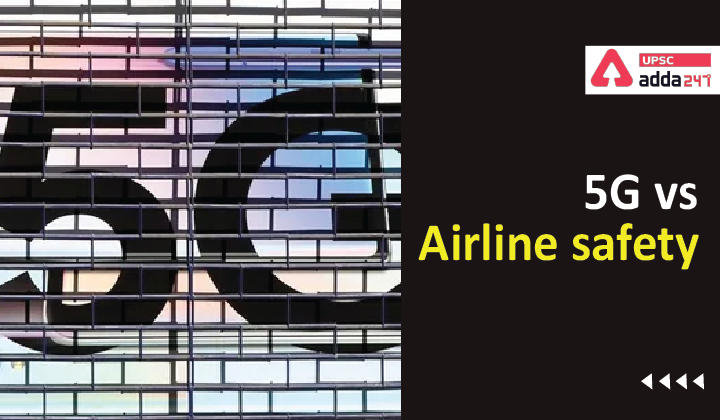Table of Contents
5G vs Airline Safety: Relevance
- GS 3: Science and Technology- developments and their applications and effects in everyday life.
5G and air safety: Context
- Recently, the chief executives of major US-based airlines have warned of a “catastrophic” aviation crisis in the backdrop of new 5G service deployment in the United States.
Is 5G a threat to air safety? Background
- Almost a year ago, United States (US) government had auctioned mid-range 5G bandwidth to mobile phone companies in in the 7-3.98 GHz range on the spectrum known as C band.
- The US Federal Aviation Administration (FAA) has warned that the new 5G technology could interfere with instruments such as altimeters and, could disrupt the airline services.

About altimeter
- Altimeter is an instrument that measure how far above the ground an airplane is travelling.
- It operates in the 2-4.4 GHz range and the experts are concerned that the auctioned range (3.7-3.98 GHz) lies very close with the range of altimeter.
- Besides, altimeter readouts are also used to facilitate automated landings and to help detect dangerous currents called wind shear.
- The US airline companies are worried that FAA’s new directive would bar the use of radio altimeters at about 40 of the biggest US airports, which could disrupt up to 4 per cent of daily flights.
Importance of frequency
- Higher the frequency, faster is the service. So, to get full value from 5G services, operators want to operate at higher frequencies.
- Some of the C band spectrum auctioned had been used for satellite radio, so the concern is that the transition to 5G means there will be much more traffic.
Is 5G dangerous for airline safety? Arguments of telecom companies
- Verizon and AT&T, two companies that has deployed 5G services, have argued that C band 5G has been deployed in about 40 other countries without aviation interference issues.
- They, however, have agreed to buffer zones around 50 airports in the United States, similar to those used in France, for six months to reduce interference risks.
Technology Innovation Group for 6G
5G and flight safety: Why not an issue elsewhere?
- In European Union (EU), the standards set for mid-range 5G frequencies lies in a 4-3.8 GHz range, which is lower than the rollout in the US.
- Spectrum used by France (3.6-3.8 GHz) sits further away from the spectrum (4.2-4.4 GHz) used for altimeters in the United States and France’s power level for 5G is much lower than what is authorized in the United States.
- In South Korea, the 5G mobile communication frequency lies in a range of 42-3.7 GHz band and there has been no report of interference with radio wave since 2019.
5G vs airline safety: What’s next?
- Verizon and AT&T have delayed their launch of 5G near some airports as the airlines warned of dire consequences for transportation and the economy.
Also Read:




 TSPSC Group 1 Question Paper 2024, Downl...
TSPSC Group 1 Question Paper 2024, Downl...
 TSPSC Group 1 Answer key 2024 Out, Downl...
TSPSC Group 1 Answer key 2024 Out, Downl...
 UPSC Prelims 2024 Question Paper, Downlo...
UPSC Prelims 2024 Question Paper, Downlo...
